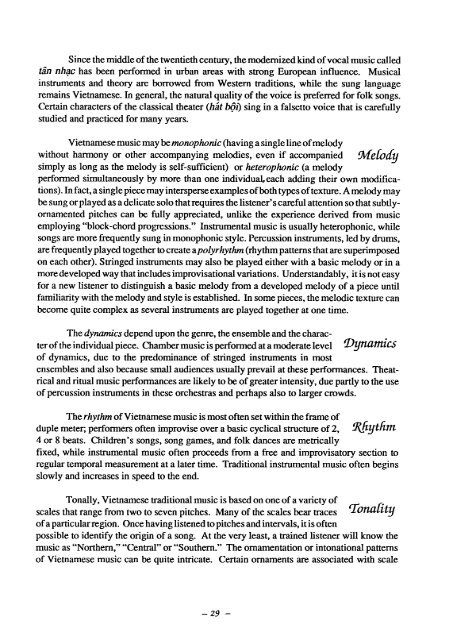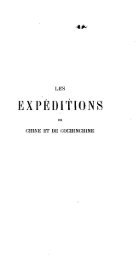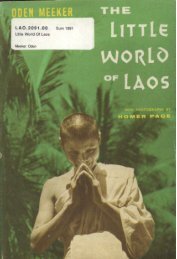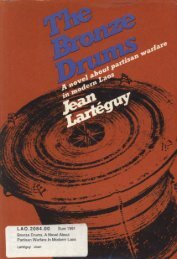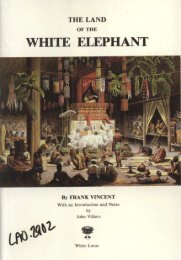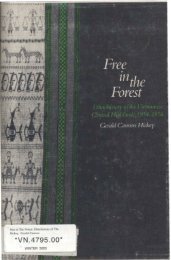and Temple Yards
iutnam From Rice Paddies and Temple Yards - Refugee Educators ...
iutnam From Rice Paddies and Temple Yards - Refugee Educators ...
- No tags were found...
You also want an ePaper? Increase the reach of your titles
YUMPU automatically turns print PDFs into web optimized ePapers that Google loves.
Since the middle of the twentieth century, the modernized kind of vocal music called<br />
tin nhac has been performed in urban areas with strong European influence. Musical<br />
instruments <strong>and</strong> theory are borrowed from Western traditions, while the sung language<br />
remains Vietnamese. In general, the natural quality of the voice is preferred for folk songs.<br />
Certain characters of the classical theater (hit @I) sing in a falsetto voice that is carefully<br />
studied <strong>and</strong> practiced for many years.<br />
Vietnamese music may be monophonic (having a single line of melody<br />
without harmony or other accompanying melodies, even if accompanied Mebdy<br />
simply as long as the melody is self-sufficient) or heterophonic (a melody<br />
performed simultaneously by more than one individual each adding their own modifications).<br />
In fact, a single piece may intersperse examples of both types of texture. A melody may<br />
be sung or played as a delicate solo that requires the listener's careful attention so that subtlyornamented<br />
pitches can be fully appreciated, unlike the experience derived from music<br />
employing "block-chord prob~essions." Instrumental music is usually heterophonic, while<br />
songs are more frequently sung in monophonic style. Percussion instruments, led by drums,<br />
are frequently played together to create apolyrhyth (rhythm patterns that are superimposed<br />
on each other). Stringed instruments may also be played either with a basic melody or in a<br />
more developed way that includes improvisational variations. Underst<strong>and</strong>ably, it is not easy<br />
for a new listener to distinguish a basic melody from a developed melody of a piece until<br />
familiarity with the melody <strong>and</strong> style is established. In some pieces, the melodic texture can<br />
become quite complex as several instruments are played together at one time.<br />
The dynamics depend upon the genre, the ensemble <strong>and</strong> the character<br />
of the individual piece. Chamber music is performed at a moderate level flvka<br />
of dynamics, due to the predominance of stringed instruments in most<br />
ensembles <strong>and</strong> also because small audiences usually prevail at these performances. Theatrical<br />
<strong>and</strong> ritual music performances are likely to be of greater intensity, due partly to the use<br />
of percussion instruments in these orchestras <strong>and</strong> perhaps also to larger crowds.<br />
The rhythm of Vietnamese music is most often set within the frame of<br />
duple meter; performers often improvise over a basic cyclical structure of 2, Rhythm<br />
4 or 8 beats. Children's songs, song games, <strong>and</strong> folk dances are metrically<br />
fixed, while instrumental music often proceeds from a free <strong>and</strong> improvisatory section to<br />
regular temporal measurement at a later time. Traditional instrumental music often begins<br />
slowly <strong>and</strong> increases in speed to the end.<br />
Tonally, Vietnamese traditional music is based on one of a variety of<br />
scales that range from two to seven pitches. Many of the scales bear traces %mfig<br />
of a particular region. Once having listened topitches <strong>and</strong> intervals, it is often<br />
possible to identify the origin of a song. At the very least, a trained listener will know the<br />
music as "Northern," "Central" or "Southern." The ornamentation or intonational patterns<br />
of Vietnamese music can be quite intricate. Certain ornaments are associated with scale


